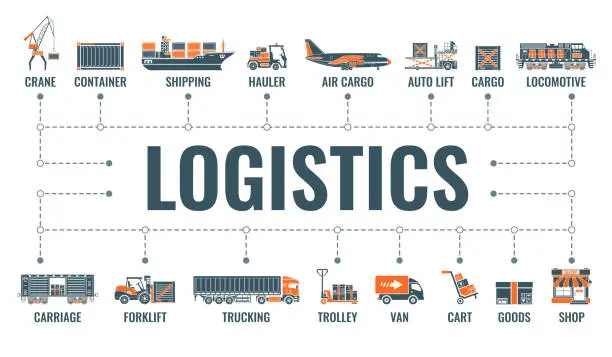
Navigating Efficiency: The Role of Freight Logistics in Global Trade
- Admin
Freight logistics stands as the backbone of global commerce, orchestrating the intricate dance of goods movement across borders, continents, and supply chains. From sourcing raw materials to delivering finished products, efficient freight logistics ensures that goods reach their destination timely, securely, and cost-effectively. In this article, we delve into the critical role of freight logistics in facilitating international trade, examine its key components and challenges, and explore the transformative impact of technology on optimizing logistics operations.
The Significance of Freight Logistics
Freight logistics encompasses the planning, coordination, and execution of transportation and distribution activities to ensure the efficient movement of goods. It involves a myriad of tasks, including route planning, freight forwarding, warehousing, inventory management, and customs clearance, all aimed at streamlining supply chain operations and minimizing transportation costs. Efficient freight logistics is essential for businesses to maintain competitiveness, meet customer demands, and navigate the complexities of global trade.
Key Components of Freight Logistics
Several key components comprise freight logistics:
Transportation Management: Transportation management involves selecting the optimal transportation modes, carriers, and routes to move goods from origin to destination. It includes tasks such as route optimization, load planning, carrier selection, and freight rate negotiation to minimize transit times and transportation costs.
Warehousing and Distribution: Warehousing and distribution play a crucial role in freight logistics, providing storage, inventory management, and order fulfillment services. Warehouses serve as hubs for consolidating, storing, and sorting goods before distribution, ensuring timely delivery and availability of inventory.
Inventory Control: Inventory control is essential for optimizing inventory levels, reducing stockouts, and minimizing carrying costs. Freight logistics professionals use inventory management techniques such as just-in-time (JIT) inventory, safety stock, and demand forecasting to maintain optimal inventory levels and meet customer demand.
Customs Clearance: Customs clearance is a critical aspect of international freight logistics, involving the submission of documentation, payment of duties and taxes, and compliance with import and export regulations. Freight forwarders and customs brokers facilitate customs clearance processes, ensuring that shipments comply with regulatory requirements and facilitating smooth cross-border trade.
Challenges in Freight Logistics
Freight logistics faces several challenges, including:
Supply Chain Disruptions: Supply chain disruptions, such as natural disasters, geopolitical conflicts, and pandemics, can disrupt freight logistics operations, causing delays, shortages, and increased transportation costs. Resilient supply chain management and contingency planning are essential for mitigating risks and maintaining continuity in logistics operations.
Infrastructure Constraints: Infrastructure constraints, such as congestion, capacity limitations, and inadequate transportation networks, can impede the efficiency of freight logistics operations. Investing in modern, resilient infrastructure and implementing infrastructure improvements are necessary to alleviate bottlenecks and enhance logistics efficiency.
Regulatory Compliance: Regulatory compliance and customs clearance requirements vary across countries and regions, posing challenges for international freight logistics. Navigating complex regulations, tariffs, and trade agreements requires expertise and resources to ensure compliance and minimize customs delays and penalties.
The Role of Technology in Optimizing Freight Logistics
Technology plays a transformative role in optimizing freight logistics operations:
Transportation Management Systems (TMS): Transportation management systems (TMS) streamline transportation planning, execution, and optimization processes. TMS software automates tasks such as route planning, carrier selection, and shipment tracking, improving visibility, efficiency, and decision-making in logistics operations.
Warehouse Management Systems (WMS): Warehouse management systems (WMS) optimize warehouse operations, including inventory management, order picking, and warehouse layout optimization. WMS software improves inventory accuracy, order fulfillment speed, and labor productivity, enhancing efficiency and customer service.
Real-Time Tracking and Visibility: Real-time tracking and visibility solutions provide visibility into the location and status of shipments throughout the supply chain. IoT sensors, GPS tracking, and cloud-based platforms enable real-time monitoring of freight movements, enhancing transparency, and responsiveness in logistics operations.
Predictive Analytics: Predictive analytics leverage data analytics and machine learning algorithms to forecast demand, optimize inventory levels, and predict transportation capacity and costs. Predictive analytics enable proactive decision-making, risk mitigation, and cost optimization in freight logistics operations.
Conclusion
Freight logistics plays a critical role in facilitating international trade, ensuring the efficient movement of goods across global supply chains. By optimizing transportation, warehousing, inventory management, and customs clearance processes, freight logistics professionals streamline supply chain operations, minimize costs, and enhance customer satisfaction. As technology continues to evolve and disrupt the logistics landscape, embracing digital solutions and innovation is essential for optimizing freight logistics operations and driving success in the global marketplace.
